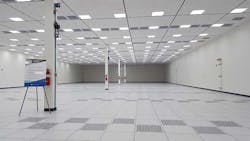Wholesale Denver Data Center Supply Focused at 4 Providers
We continue our series of stories on the leading geographic markets for data center space. Data Center Frontier is partnering with datacenterHawk to provide in-depth market reports on each city we profile. This time, we visit the Denver Data Center Market, one of the fastest-growing technology ecosystems in the U.S. In this excerpt, we explore wholesale Denver data center supply, which is limited to four colocation providers.
Download the full report.
Data center development in Denver is relatively spread out grographically, with a slightly higher density of data centers in the Centennial and Englewood areas southeast of downtown. Apart from Iron Mountain’s purpose-built facility, Denver’s downtown data centers are located primarily in retrofit buildings with dense fiber infrastructure, while most of the purpose-built data centers are located in the surrounding suburbs.
Wholesale Denver supply is limited to four providers: Flexential, Iron Mountain, EdgeConnex, and H5 Data Centers.
Flexential
Flexential is Denver’s largest data center provider, with 26 MW of commissioned power across five data centers, and the ability to add another 9 MW in the future. Most of the company’s capacity is concentrated in its Compark data center, a wholesale facility capable of offering 17 MW of commissioned power at full delivery. Flexential has been the Denver market share leader since its tenure as ViaWest. The Denver-based regional provider focused mainly on second-tier markets before being acquired by Peak 10 in 2017, rebranding as Flexential, and evolving to more of a national footprint. Although Flexential is the largest player, newer providers to the Denver market are creating a more competitive environment.
Iron Mountain
One of the fastest-growing colocation providers in the world is Iron Mountain with its more than $2 billion in data center investment since 2017. FORTRUST and its 16-megawatt data center (now named DEN-1) in downtown Denver was the first of a string of Iron Mountain acquisitions that included IO Data Centers, EvoSwitch, and two Credit Suisse facilities in London and Singapore, respectively. Iron Mountain DEN-1 has the largest customer count of any individual data center in the front range, is powered by 100% renewable energy, and boasts one of the longest continuous uptime streaks in the world at more than 17 years. At 210,000 square feet, Iron Mountain DEN-1 has private suite wholesale customers as well as wholesale customers taking down dedicated MOD’s. Additionally, DEN-1 was the first colocation facility in Denver to receive an on-premises MegaPort exchange to help streamline hybrid IT and multi-cloud management for its diverse customer base.
Iron Mountain DEN-1 has the largest customer count of any individual data center in the front range, is powered by 100% renewable energy, and boasts one of the longest continuous uptime streaks in the world at more than 17 years.
EdgeConneX
EdgeConneX expanded its Denver campus in 3Q 2018, completing the construction of a new powered shell. EdgeConneX built the 115,000 SF shell in roughly six months, and will offer colocation at a density of up to 30 kW per rack. Additionally, Iron Mountain and EdgeConneX will offer Megaport services at the data center, giving users a direct, private, and secure connection between their colocation and cloud environments. EdgeConneX is in talks with several potential tenants, but doesn’t anticipate building out the space for two years due to their remaining capacity at their existing data center adjacent to the shell.
H5 Data Centers
H5 completed a multi-million dollar upgrade to its campus in the Denver Tech Center, bringing on new private suites ready for wholesale consumption. The facility was originally a production data center for a prominent airline and now houses production and backup infrastructure for a wide-range of customers.
Stay tuned next week for an update on the Denver business environment for the data center industry. The Denver Data Center Market Report also covered the following topics.
Download the full Data Center Frontier “Denver Data Center Market” special report, courtesy of Iron Mountain Data Centers.
About the Author



